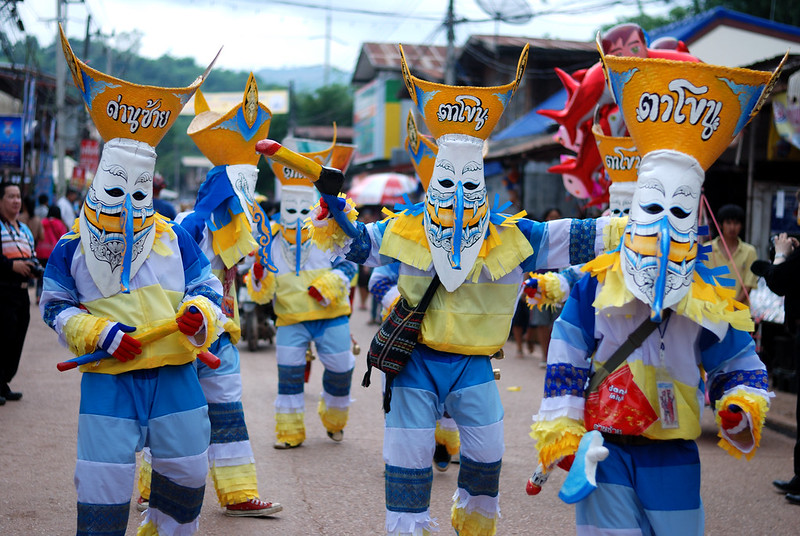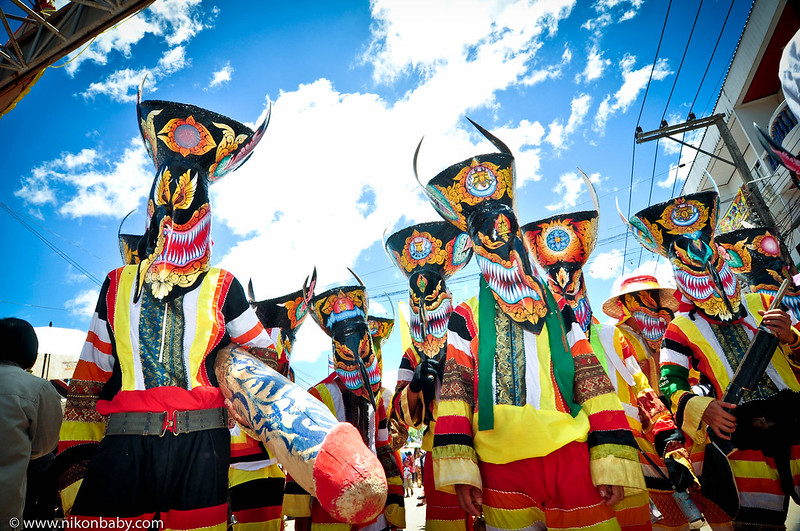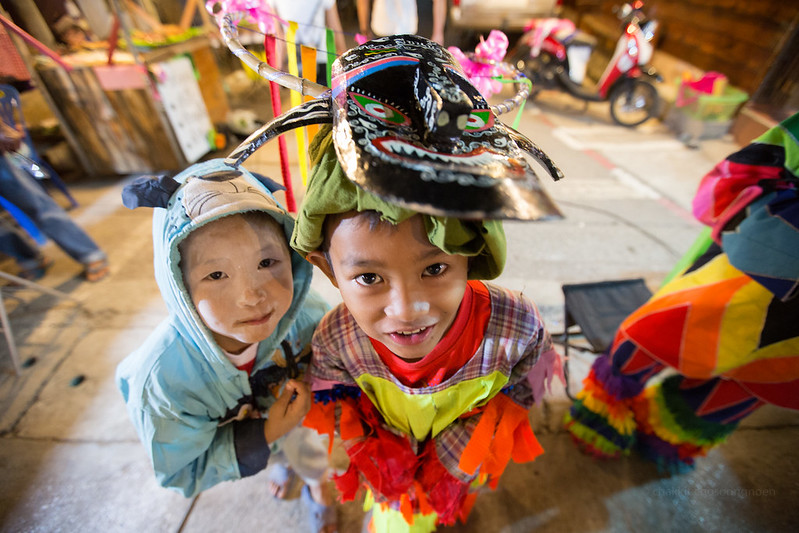Phi Ta Khon Festival
The Festival of Dancing Spirits
2022/06/30 - 2022/07/02
Every early summer, the town of Dan Sai in Loei Province, northeastern Thailand, is transformed by the riot of color, sound, and laughter that is the Phi Ta Khon Festival. For three days-usually in late June to early July-locals and visitors alike don fantastical masks and parade through the streets, experiencing a unique world where Buddhist legends, animist beliefs, and boundless cheerfulness blend together. Whether you’re drawn by the colorful costumes, hypnotic rhythms, or Loei’s local cuisine, families and adventurous travelers alike will find themselves swept up in a festival where the boundary between the living and the spirit world becomes delightfully blurred.
Main Attractions
The Parade of Spirits and Rituals
The heart of Phi Ta Khon is its parade. Villagers wear giant, handmade masks crafted from coconut husks and sticky rice steamers as they wind through Dan Sai’s narrow streets. The sound of cowbells, the laughter of the “spirits,” and the rhythm of Isaan drums fill the air, while revelers playfully tease onlookers with wooden phalluses-symbols of fertility and good luck. This playful yet sacred atmosphere is unique to the festival. The parade leads sacred Buddhist objects and spirit mediums through the town, praying for protection and blessings for the year. “Phi Ta Khon” means “spirits following people,” reflecting the belief that spirits visit the human world during the festival.
The festival lasts three days. It begins with Buddhist merit-making and the summoning of spirits at Wat Phon Chai Temple. The second day is the main event, featuring mask and dance contests and the launching of bamboo rockets (for rain). The final day is devoted to Buddhist sermons, with locals gathering at the temple to hear the story of Prince Vessantara, the Buddha’s previous incarnation-a legend that is said to be the origin of Phi Ta Khon.
Masks, Costumes, and Decorations
Few festivals in Thailand rival Phi Ta Khon for visual impact. Some masks stretch over a meter tall, painted in vivid blues, reds, and yellows, with long noses and fierce eyes giving each spirit a unique personality. Costumes are patchworks sewn from scraps, with bells and amulets jangling from every belt. Some revelers carry wooden swords or oversized phallic symbols, playfully teasing the crowd. Homes and temples are decorated with colorful flags, lanterns, and bamboo crafts, while the streets fill with food stalls and craft markets.
Traditional Food and Drink
During the festival, the sweet aroma of grilled meats and sticky rice fills the town. Street stalls offer Loei sausages, Laotian-style grilled chicken, black sticky rice, spicy som tam (green papaya salad), and-for the brave-crispy fried insects. To beat the heat, locals enjoy black sticky rice wine, homemade rice whisky, and coconut water, each balancing the festival’s fiery energy with a cool, earthy note.
Cultural and Historical Background
Phi Ta Khon is a festival where Buddhist legends, spirit beliefs, and agricultural rituals converge. It is part of the larger Bun Luang merit-making festival, and its origin lies in the legend of Prince Vessantara, a previous life of the Buddha. When the prince returned home after a long journey, the villagers were so overjoyed that even the forest spirits awoke and joined in the celebration. To this day, the festival expresses gratitude to the spirits and prays for a good harvest and protection from misfortune.
In the past, it was believed that not holding the festival would bring disaster-drought, illness, or famine. Phi Ta Khon symbolizes the close connection between the spirit and human worlds in Thai culture. Once, masks and costumes were floated down the Man River to ward off bad luck, but now they are carefully kept for the next year. Phi Ta Khon remains a living tradition of gratitude, hope, and communal prayer to ancestors and spirits.
Participant Voices
"I came to Dan Sai wanting to see a quirky ghost parade, but what I found was like stepping into a living folktale. On the first morning, I joined locals at Wat Phon Chai for alms-giving, offering sticky rice to monks as the sun rose. Later, as masked dancers passed by, a boy in patchwork handed me a bell and laughed, 'Now you’re one of the spirits too!' The energy was unforgettable. I danced until my feet hurt, and the memory still makes me smile."
Fun Facts
- Some masks are over a meter tall and can take weeks to carve and paint.
- In the past, costumes were floated down the Man River to ward off bad luck, but now they are kept for the next year’s festival.
- The festival features water buffalo races (Khwai Tu) and rocket launches for rain.
- Phi Ta Khon is part of the Bun Luang festival, which also includes Buddhist sermons, merit-making, and folk plays.
Festival Dates
The dates are set each year by local monks according to the lunar calendar (usually late June to early July).
The event schedule is subject to change. Please check the official website for the most up-to-date information.
Media
Information
| Name | Phi Ta Khon Festival |
| Country | Thailand |
| Area | Dan Sai |
| Date | 2022/06/30 - 2022/07/02 |
| Link |
Upcoming Festivals
Whirling Dervishes Festival Turkey
A Mesmerizing Dance of Divine Love
2025/12/06Mevlana Celaleddin Rumi Commemoration Ceremony ( Şeb-i Arus ) Turkey
A Whirling Journey to Divine Love
2025/12/10Dia de la Virgen de Guadalupe Mexico
A Festival Weaving Faith, Fervor, and Mexican Identity
2025/12/11L'Escalade Switzerland
Geneva’s Grand Winter Festival of Courage, Chocolate, and Community
2025/12/12Umkhosi Wokweshwama South Africa
The Zulu First Fruits Festival—A Sacred Celebration of Land, Ancestors, and Renewal
2025/12/12Lucia Festival (St. Lucia's Day) Sweden
A Festival of Light Illuminating the Nordic Darkness
2025/12/15Las Posadas Mexico
The Luminous Quest for Sacred Shelter
2025/12/22Noche de Rabanos (Night of the Radishes) Mexico
A celebration blending art, farming heritage, and cultural traditions
2025/12/23Chant of the Sybil on Majorca Spain
A Medieval Prophecy Echoes Through Majorcan Christmas
2025/12/23‘Hatajo de Negritos’ and the ‘Hatajo de Pallitas’ Peru
A Christmas Festival of Rhythm, Faith, and Afro-Andean Heritage in Peru’s Ica Region



